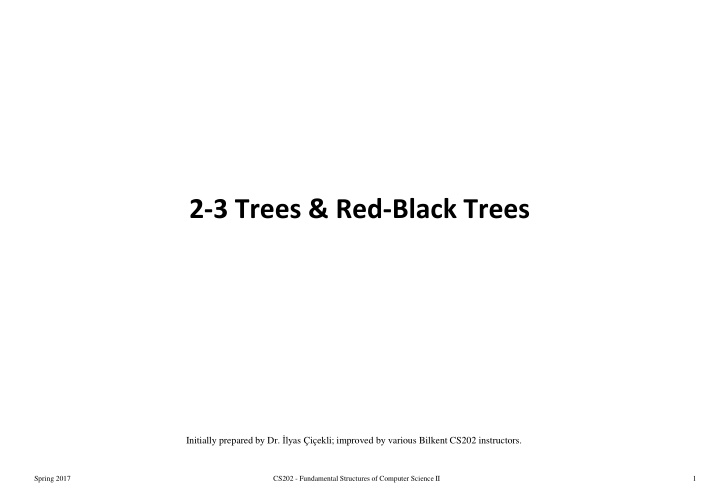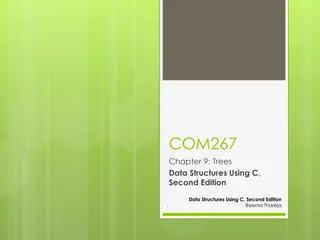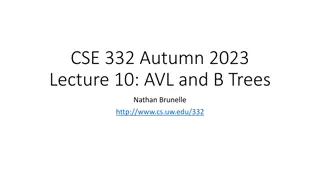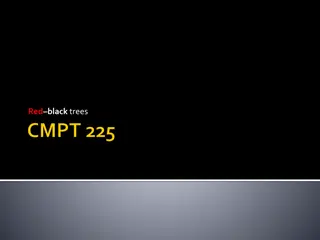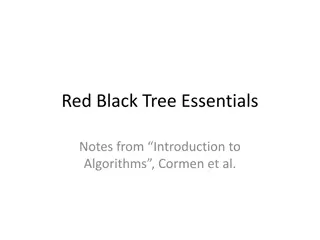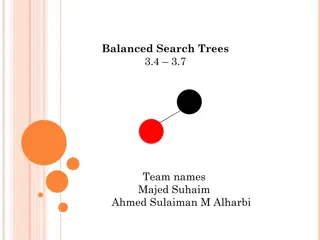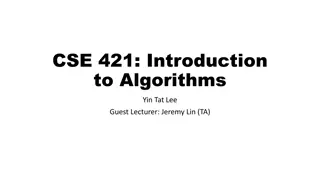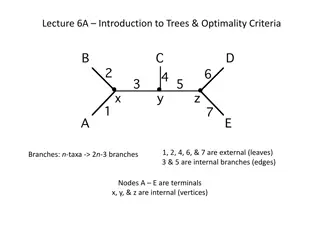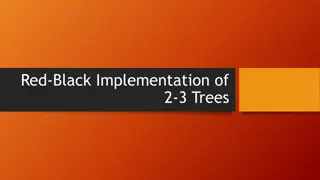2-3 Trees and Red-Black Trees Overview
This content provides insights into 2-3 trees and red-black trees, discussing their definitions, properties, implementations in C++, and traversal techniques. It covers important concepts such as node structures, tree heights, and inorder traversal. Visual aids and examples enhance understanding, making it a valuable resource for studying these fundamental data structures.
Download Presentation

Please find below an Image/Link to download the presentation.
The content on the website is provided AS IS for your information and personal use only. It may not be sold, licensed, or shared on other websites without obtaining consent from the author.If you encounter any issues during the download, it is possible that the publisher has removed the file from their server.
You are allowed to download the files provided on this website for personal or commercial use, subject to the condition that they are used lawfully. All files are the property of their respective owners.
The content on the website is provided AS IS for your information and personal use only. It may not be sold, licensed, or shared on other websites without obtaining consent from the author.
E N D
Presentation Transcript
2-3 Trees & Red-Black Trees Initially prepared by Dr. lyas i ekli; improved by various Bilkent CS202 instructors. Spring 2017 CS202 - Fundamental Structures of Computer Science II 1
2-3 Trees Definition: A 2-3 tree is a tree in which each internal node has either two or three children, and all leaves are at the same level. 2-node: a node with two children 3-node: a node with three children An example of a 2-3 tree A 2-3 tree is not a binary tree A 2-3 tree is never taller than a minimum-height binary tree A 2-3 tree with N nodes never has height greater than log2(N+1) A 2-3 tree of height h always has at least 2h-1 nodes. Spring 2017 CS202 - Fundamental Structures of Computer Science II 2
2-3 Trees T is a 2-3 tree of height h if 1. T is empty (a 2-3 tree of height 0), or 2-node 2. T is of the form r TL TR where r is a node that contains one data item and TL and TR are both 2-3 trees, each of height h-1, or 3. T is of the form 3-node r TL TM TR where r is a node that contains two data items and TL , TM and TR are 2-3 trees, each of height h-1. Spring 2017 CS202 - Fundamental Structures of Computer Science II 3
2-3 Trees -- Example Spring 2017 CS202 - Fundamental Structures of Computer Science II 4
C++ Class for a 2-3 Tree Node classTreeNode { private: TreeItemTypesmallItem, largeItem; TreeNode *leftChildPtr, *midChildPtr, *rightChildPtr; // friend class-can access private class members friend classTwoThreeTree; }; When a node is a 2-node (contains only one item) Place it in smallItem Use leftChildPtr and midChildPtr to point to the node s children Place NULL in rightChildPtr Spring 2017 CS202 - Fundamental Structures of Computer Science II 5
Traversing a 2-3 Tree Inorder traversal visits the nodes in a sorted search-key order Leaf node: Visit the data item(s) 2-node: Visit its left subtree Visit the data item Visit its right subtree 3-node: Visit its left subtree Visit the smaller data item Visit its middle subtree Visit the larger data item Visit its right subtree Spring 2017 CS202 - Fundamental Structures of Computer Science II 6
Searching a 2-3 Tree Searching a 2-3 tree is similar to searching a binary search tree For a 3-node, compare the searched key with the two values of the 3-node and select one of its three subtrees according to these comparisons Searching a 2-3 tree is O(log N) Searching a 2-3 tree and the shortest BST has approximately the same efficiency. A binary search tree with N nodes cannot be shorter than log2(N+1) A 2-3 tree with N nodes cannot be taller than log2(N+1) A 2-3 tree with the same elements A balanced binary search tree Spring 2017 CS202 - Fundamental Structures of Computer Science II 7
Inserting into a 2-3 Tree Insert [ 39 38 37 36 35 34 33 32 ] into the trees given in the previous slide While we insert items into a 2-3 tree, its shape is maintained Spring 2017 CS202 - Fundamental Structures of Computer Science II 8
Inserting into a 2-3 Tree -- Example Starting from the following tree, insert [ 39 38 37 36 35 34 33 32 ] Insert 39 Find the node into which you can put 39 Insertion into a 2-node leaf is simple Spring 2017 CS202 - Fundamental Structures of Computer Science II 9
Inserting into a 2-3 Tree -- Example Insert 38 Find the node into which you can put 38 Insertion into a 3-node causes it to divide Spring 2017 CS202 - Fundamental Structures of Computer Science II 10
Inserting into a 2-3 Tree -- Example Insert 37 Find the node into which you can put 37 Insertion into a 2-node leaf is simple Spring 2017 CS202 - Fundamental Structures of Computer Science II 11
Inserting into a 2-3 Tree -- Example Insert 36 Find the node into which you can put 36 Spring 2017 CS202 - Fundamental Structures of Computer Science II 12
Inserting into a 2-3 Tree -- Example Insert 35, 34, 33 Spring 2017 CS202 - Fundamental Structures of Computer Science II 13
2-3 Trees -- Insertion Algorithm Splitting a leaf in a 2-3 tree Spring 2017 CS202 - Fundamental Structures of Computer Science II 14
2-3 Trees -- Insertion Algorithm Splitting an internal node in a 2-3 tree Spring 2017 CS202 - Fundamental Structures of Computer Science II 15
2-3 Trees -- Insertion Algorithm Splitting the root of a 2-3 tree Spring 2017 CS202 - Fundamental Structures of Computer Science II 16
Deleting from a 2-3 tree Deletion strategy is the inverse of insertion strategy. Deletion starts like normal BST deletion (swap with inorder successor) Then, we merge the nodes that have become underloaded. 50 Delete [ 70 100 80 ] from this 2-3 tree 70 90 30 10 20 40 60 80 100 Spring 2017 CS202 - Fundamental Structures of Computer Science II 17
Deleting from a 2-3 Tree -- Example 50 50 50 50 50 50 70 90 80 90 80 90 80 90 90 90 30 30 30 30 30 30 Resulting tree 10 20 10 20 10 20 10 20 10 20 10 20 60 80 60 80 40 40 40 40 40 40 60 60 60 60 80 70 100 100 100 100 100 100 Delete 70 Swap with inorder successor Delete value from leaf Delete the empty leaf Shrink the parent (no more mid-pointer) Spring 2017 CS202 - Fundamental Structures of Computer Science II 18
Deleting from a 2-3 Tree -- Example 50 50 50 50 50 30 30 30 30 30 90 90 90 80 80 Resulting tree 10 20 10 20 10 20 10 20 10 20 60 80 60 80 60 60 60 40 40 40 40 40 100 80 90 90 Delete 100 Delete value from leaf Distribute the children Redistribute the parent and the children Doesn t work Spring 2017 CS202 - Fundamental Structures of Computer Science II 19
Deleting from a 2-3 Tree -- Example Root becomes empty 50 50 50 50 30 50 30 50 Node becomes empty 30 30 30 30 80 90 90 10 20 60 90 40 10 20 10 20 10 20 10 20 10 20 60 90 60 90 40 40 40 40 40 60 60 60 90 80 Delete 80 Swap with inorder successor Delete value from leaf Merge by moving 90 down and removing the empty leaf Merge by moving 50 down, adopting empty node s child and removing the empty node Remove empty root Spring 2017 CS202 - Fundamental Structures of Computer Science II 20
2-3 Trees -- Deletion Algorithm To delete an item X from a 2-3 tree: First, we locate the node n containing X. If n is not a leaf, we find X's inorder successor and swap it with X. After the swap, the deletion always begins at the leaf. If the leaf contains another item in addition to X, we simply delete X from that leaf, and we are done. If the leaf contains only X, deleting X would leave the leaf without a data item. In this case, we must perform some additional work to complete the deletion. Depending on the empty node and its siblings, we perform certain operations: Delete empty root Merge nodes Redistribute values These operations can be repeated all the way upto the root if necessary. Spring 2017 CS202 - Fundamental Structures of Computer Science II 21
2-3 Trees -- Deletion Operations Deleting the root Spring 2017 CS202 - Fundamental Structures of Computer Science II 22
2-3 Trees -- Deletion Operations Redistributing values (and children) For a leaf For an internal node Spring 2017 CS202 - Fundamental Structures of Computer Science II 23
2-3 Trees -- Deletion Operations Merging For a leaf For an internal node Spring 2017 CS202 - Fundamental Structures of Computer Science II 24
2-3 Trees -- Analysis We can use a 2-3 tree in the implementation of tables. A 2-3 tree has the advantage of always being balanced. Thus, insertion and deletion operations are O(log N) Retrieval based on key is also guaranteed to O(log N) Spring 2017 CS202 - Fundamental Structures of Computer Science II 25
2-3-4 Trees A 2-3-4 tree is like a 2-3 tree, but it allows 4-nodes, which are nodes that have four children and three data items. There is a close relation between 2-3-4 trees and red-black trees. We will look at those a bit later 2-3-4 trees are also known as 2-4 trees in other books. A specialization of M-way tree (M=4) Sometimes also called 4th order B-trees Variants of B-trees are very useful in databases and file systems MySQL, Oracle, MS SQL all use B+ trees for indexing Many file systems (NTFS, Ext2FS etc.) use B+ trees for indexing metadata (file size, date etc.) Although a 2-3-4 tree has more efficient insertion and deletion operations than a 2-3 tree, a 2-3-4 tree has greater storage requirements. Spring 2017 CS202 - Fundamental Structures of Computer Science II 26
2-3-4 Trees -- Example Spring 2017 CS202 - Fundamental Structures of Computer Science II 27
2-3-4 Trees 2-node T is a 2-3-4 tree of height h if 1. T is empty (a 2-3-4 tree of height 0), or r 1. T is of the form TR TL 3-node where r is a node containing one data item and TL and TR are both 2-3-4 trees, each of height h-1, or r 3. T is of the form TL TM TR where r is a node containing two data items and TL , TM and TR are 2-3-4 trees, each of height h-1, or 4-node r 4. T is of the form TL TML TMR TR where r is a node containing three data items and TL , TML , TMR , and TR are 2-3-4 trees, each of height h-1. Spring 2017 CS202 - Fundamental Structures of Computer Science II 28
C++ Class for a 2-3-4 Tree Node classTreeNode { private: TreeItemTypesmallItem, middleItem, largeItem; TreeNode *leftChildPtr, *lMidChildPtr; TreeNode *rMidChildPtr, *rightChildPtr; friendclassTwoThreeFourTree; }; When a node is a 3-node (contains only two items) Place the items in smallItem and middleItem Use leftChildPtr, lMidChildPtr, rMidChildPtr to point to the node s children Place NULL in rightChildPtr When a node is a 2-node (contains only one item) Place the item in smallItem Use leftChildPtr, lMidChildPtr to point to the node s children Place NULL in rMidChildPtr and rightChildPtr Spring 2017 CS202 - Fundamental Structures of Computer Science II 29
2-3-4 Trees -- Operations Searching and traversal algorithms for a 2-3-4 tree are similar to the 2- 3 algorithms. For a 2-3-4 tree, insertion and deletion algorithms that are used for 2- 3 trees, can similarly be used. But, we can also use a slightly different insertion and deletion algorithms for 2-3-4 trees to gain some efficiency. Spring 2017 CS202 - Fundamental Structures of Computer Science II 30
Inserting into a 2-3-4 Tree Splits 4-nodes by moving one of its items up to its parent node. For a 2-3 tree, the insertion algorithm traces a path from the root to a leaf and then backs up from the leaf as it splits nodes. To avoid this return path after reaching a leaf, the insertion algorithm for a 2-3-4 tree splits 4-nodes as soon as it encounters them on the way down the tree from the root to a leaf. As a result, when a 4-node is split and an item is moved up to node s parent, the parent cannot possibly be a 4-node and so can accommodate another item. Insert[ 20 50 40 70 80 15 90 100 ] to this 2-3-4 tree 10 30 60 Spring 2017 CS202 - Fundamental Structures of Computer Science II 31
Inserting into a 2-3-4 Tree -- Example 10 30 60 30 30 10 30 60 10 20 10 60 60 Insert 20 Root is a 4-node So, we split it before insertion Split 4-nodes as they are encountered And, then add 20 Spring 2017 CS202 - Fundamental Structures of Computer Science II 32
Inserting into a 2-3-4 Tree -- Example 30 30 30 10 20 10 20 10 20 50 60 40 50 60 60 Insert 50 and 40 No 4-nodes have been encountered during their insertion No split operation Spring 2017 CS202 - Fundamental Structures of Computer Science II 33
Inserting into a 2-3-4 Tree -- Example 30 50 30 50 30 30 10 20 10 20 10 20 10 20 40 50 60 40 50 60 60 60 70 40 40 Insert 70 A 4-node is encountered So, we split it before insertion And, then add 70 Spring 2017 CS202 - Fundamental Structures of Computer Science II 34
Inserting into a 2-3-4 Tree -- Example 30 50 30 50 30 50 10 20 10 20 10 15 20 60 70 60 70 80 60 70 80 40 40 40 Insert 80 and 15 No 4-nodes have been encountered during their insertion No split operation Spring 2017 CS202 - Fundamental Structures of Computer Science II 35
Inserting into a 2-3-4 Tree -- Example 30 50 30 50 30 50 70 30 50 70 10 15 20 10 15 20 10 15 20 10 15 20 60 70 80 60 70 80 80 80 90 40 40 40 40 60 60 Insert 90 A 4-node is encountered So, we split it before insertion And, then add 90 Spring 2017 CS202 - Fundamental Structures of Computer Science II 36
Inserting into a 2-3-4 Tree -- Example 30 50 70 30 50 70 50 50 10 1520 10 1520 80 90 80 90 40 40 60 60 30 30 70 70 10 15 20 10 15 20 80 90 80 90 100 40 40 60 60 Insert 100 A 4-node is encountered So, we split it before insertion And, then add 100 Spring 2017 CS202 - Fundamental Structures of Computer Science II 37
Splitting 4-nodes during insertion We split each 4-node as soon as we encounter it during our search from the root to a leaf that will accommodate the new item to be inserted. The 4-node which will be split can: be the root, or have a 2-node parent, or have a 3-node parent. Spring 2017 CS202 - Fundamental Structures of Computer Science II 38
Splitting 4-nodes during insertion Splitting a 4-node root Spring 2017 CS202 - Fundamental Structures of Computer Science II 39
Splitting 4-nodes during insertion Splitting a 4-node whose parent is a 2-node Spring 2017 CS202 - Fundamental Structures of Computer Science II 40
Splitting 4-nodes during insertion Splitting a 4-node whose parent is a 3-node Spring 2017 CS202 - Fundamental Structures of Computer Science II 41
Deleting from a 2-3-4 tree For a 2-3 tree, the deletion algorithm traces a path from the root to a leaf and then backs up from the leaf, fixing empty nodes on the path back up to root. To avoid this return path after reaching a leaf, the deletion algorithm for a 2-3-4 tree transforms each 2-node into either 3-node or 4-node as soon as it encounters them on the way down the tree from the root to a leaf. If an adjacent sibling is a 3-node or 4-node, transfer an item from that sibling to our 2-node. If adjacent sibling is a 2-node, merge them. Spring 2017 CS202 - Fundamental Structures of Computer Science II 42
Red-Black Trees In general, a 2-3-4 tree requires more storage than a binary search tree. A special binary search tree, the red-black-tree, can be used to represent a 2-3-4 tree, so that we can retain advantages of a 2-3-4 tree without a storage overhead. 3-node and 4-nodes in a 2-3-4 tree are represented by a binary tree. To distinguish the original 2-nodes from 2-nodes that are generated from 3- nodes and 4-nodes, we use red and black pointers. All original pointers in a 2-3-4 tree are black pointers, red pointers are used for child pointers to link 2-nodes that result from the split of 3-nodes and 4- nodes. Spring 2017 CS202 - Fundamental Structures of Computer Science II 43
Red-Black Trees Red-black tree representation For a 4-node For a 3-node Spring 2017 CS202 - Fundamental Structures of Computer Science II 44
Red-Black Trees -- Properties Root is always a black node. The children of a red node (pointed by a red pointer) are always black nodes (pointed by a black pointer) All external nodes (leaves and nodes with a single child) should have the same number of black pointers on the path from the root to that external node. Spring 2017 CS202 - Fundamental Structures of Computer Science II 45
A 2-3-4 Tree and Its Corresponding Red-Black Tree 37 50 30 35 70 90 39 10 20 32 33 34 36 38 40 60 80 100 37 30 50 20 35 39 90 38 40 70 100 10 33 36 32 34 60 80 Spring 2017 CS202 - Fundamental Structures of Computer Science II 46
C++ Class for a Red-Black Tree Node enum Color {RED, BLACK}; classTreeNode { private: TreeItemType Item; TreeNode *leftChildPtr, *rightChildPtr; Color leftColor, rightColor; friendclassRedBlackTree; }; Spring 2017 CS202 - Fundamental Structures of Computer Science II 47
Splitting in a Red-Black Tree Representation For a 4-node that is the root Spring 2017 CS202 - Fundamental Structures of Computer Science II 48
Splitting in a Red-Black Tree Representation For a 4-node whose parent is a 2-node Spring 2017 CS202 - Fundamental Structures of Computer Science II 49
Splitting in a Red-Black Tree Representation For a 4-node whose parent is a 3-node Spring 2017 CS202 - Fundamental Structures of Computer Science II 50
